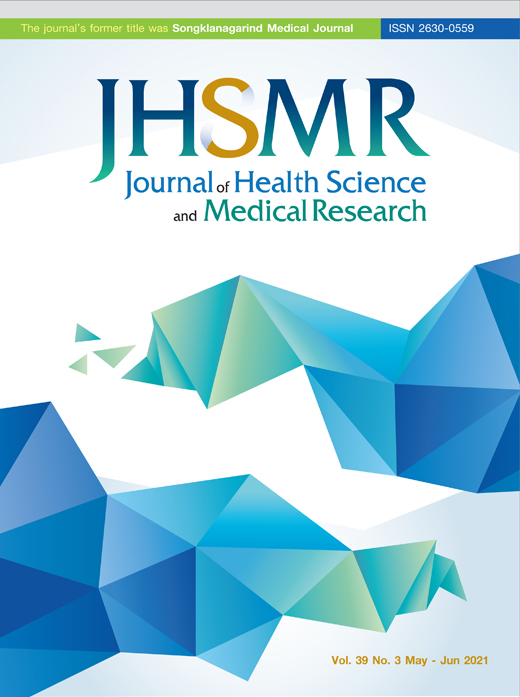Factors that Influence Menstrual Hygiene Management in Adolescent Girls in Mudon Township, Mon State, Myanmar
DOI:
https://doi.org/10.31584/jhsmr.2021778Keywords:
adolescence, girls, menstrual hygiene management, MyanmarAbstract
Objective: The study assessed the underlying factors that influence menstrual hygiene management (MHM) in adolescent girls, and how it can have an effect on the girls’ education, health and daily life.
Material and Methods: A community-based, quantitative cross-sectional study was conducted through face-to-face interviews, with 410 adolescent girls. Descriptive statistics, chi-square, bivariate and multivariate logistic regression were applied, to describe and predict significant associations and predictors between MHM and its independent variables; such as knowledge, attitudes and practices related to menstruation, and accessibility of MHM facilities.
Results: More than half of the respondents had poor MHM levels. Menstrual knowledge [adjusted odds ratio (AOR)= 2.17, 95% confidence interval (CI): 1.32-3.56], attitude towards menstruation (AOR=1.65, 95% CI: 1.11-2.46), menstrual hygiene practices (AOR=2.53, 1.78-3.98) and the accessibility of MHM facilities (AOR=2.44, 95% CI: 1.29-4.62) were the factors associated with MHM. Girls with poor MHM levels were 1.1 times more likely to be affected in their daily activities, as compared to those with good MHM levels.
Conclusion: The adolescent girls participating in the study were still unable to manage their menstrual hygiene well, owing to their inadequate knowledge in relation to menstruation, unhealthy menstrual hygiene practices; and the limited accessibility to MHM facilities. Establishment of such correlation necessitates; for instance, setting up a menstrual health education program as well as provision of MHM facilities, will enable the adolescent girls in Mudon Township, Mon State, Myanmar to minimize the negative impacts on their daily lives.
References
Thakur H, Aronsson A, Bansode S, Lundborg CS, Dalvie S, Faxelid E. Knowledge, practices, and restrictions related to menstruation among young women from low socioeconomic community in Mumbai, India. Front Public Health 2014;2:72.
House S, Mahon T, Cavill S. Menstrual hygiene matters: a resource for improving menstrual hygiene around the world. Reprod Health Matters 2013;21:257-9.
United Nations Children's Fund. Good practice guilddance of menstrual hygiene maanagement [monograph on the Internet]. New York: United Nations Children's Fund; 2017 [cited 2017 Dec 12]. Available from: https://www.unicef.org/eapro/ MHM_Good_Practice_Guidance_Note_opti.pdf
Dutta D, Badloe C, Lee H, House S. Supporting the rights of girls and women through menstrual hygiene management (MHM) in the East Asia and Pacific Region: realities, progress and opportunities [monograph on the Internet]. Bangkok: United Nations Children's Fund East Asia and Pacific Regional Office; 2016 [cited 2017 Feb 18]. Available from: https://menstrualhygieneday.org/supporting-rightsgirls- women-menstrual-hygiene-management-mhm-eastasia- pacific-region/
Nitar W. Menstrual knowledge and practices of rural women in Taungdwingyi Township: a situational analysis. Myanmar Army Health J 2017;4:37-40.
Parker HA, Smith AJ, Verdemato T, Webster J, Carter RC. Menstrual management: a neglected aspect of hygiene interventions. Disaster Prev Manag 2014;23:437-54.
Khin YY. Awareness and practices related to menstrual hygiene among adolescent schoolgirls in Mawlamyinegyun Township. Yangon: University of Public Health; 2014.
Misra P, Upadhyay RP, Sharma V, Anand K, Gupta V. A community-based study of menstrual hygiene practices and willingness to pay for sanitary napkins among women of a rural community in northern India. Natl Med J India 2013;26: 335-7.
Guerry E. An assessment of menstrual hygiene practices and absenteeism in Western Uganda. Sheffield: University of Sheffield; 2013.
Alam MU, Luby SP, Halder AK, Islam K, Opel A, Shoab AK, et al. Menstrual hygiene management among Bangladeshi adolescent schoolgirls and risk factors affecting school absence: results from a cross-sectional survey. BMJ Open 2017;7:e015508. 11. Schmitt ML, Clatworthy D, Ratnayake R, Klaesener-Metzner N, Roesch E, Wheeler E, Sommer M. Understanding the menstrual hygiene management challenges facing displaced girls and women: findings from qualitative assessments in Myanmar and Lebanon. Confl Health 2017;11:19.
Yasmin S, Manna N, Mallik S, Ahmed A, Baisakhi P. Menstrual hygiene among adolescent school students: an in-depth cross-sectional study in an urban community of West Bengal, India. IOSR J Pharm 2013;5:22-6.
Haver J, Long JL. Menstrual hygiene management operational guidelines [monograph on the Internet]. Long Island Council: Save the Children; 2014 [cited 2017 Sep 23]. Available from: https://www.savethechildren.org/content/dam/global/ reports/health-and-nutrition/mens-hyg-mgmt-guide.pdf
Juyal R, Kandpal S, Semwal J. Menstrual hygiene and reproductive morbidity in adolescent girls in Dehradun, India. Bangladesh J Med Sci 2014;13:170.
Sumpter C, Torondel B. A systematic review of the health and social effects of menstrual hygiene management. PLOS ONE 2013;8:e62004.
Ilo CI, Nwimo IQ, Onwunaka, C. Menstrual hygiene practices and sources of menstrual hygiene information among adolescent secondary school girls in Abakaliki education zone of Ebonyi State. J Educ Pract 2016;7:88-95.
Tegegne TK, Sisay MM. Menstrual hygiene management and school absenteeism among female adolescent students in Northeast Ethiopia. BMC Public Health 2014;14:1118.
Bingley K. Partnerships review: research for health in humanitarian crises [monograph on the Internet]. London: Elrha; 2019 [cited 2019 Sep 30]. Available from: https://reliefweb.int/sites/ reliefweb.int/files/resources/Partnership-Review-R2HCFINAL. pdf
Cobb NJ. Adolescence: continuity, change, and diversity. California: Mayfield Publishing; 1992.
Burnet Institute. Adolescent reproductive health in Myanmar: formative research to support the delivery of life-skills education and hygiene improvements through monastic schools in Magway, Myanmar [monograph on the Internet]. Melbourne: Burnet Institute; 2017 [cited 2018 May 24]. Available from:https://www.burnet.edu.au/projects/262_adolescent_ reproductive_health_in_myanmar
Wash in school [homepage on the Internet]. Yangon: Aung Yadanar Association [cited 2018 Jun 1]. Available from: http://washinschoolsmapping.com/contact.html
Kennedy EWS, Macintyre A, Huggett C, Wheen R. Menstrual hygiene management Indonesia: Understanding practices, determinants and practices, determinants and impacts among adolescents school girls Indonesia [monograph on the Internet]. Yakata: United Nations Children's Fund: Indonesia, Burnet Institute S, Water Aid Australia, Aliansi Rem aja Independen; 2015 [cited 2017 May 20]. Available from: https://www. communityledtotalsanitation.org/sites/communityledtotal sanitation.org/files/MHM_Indonesia.pdf
Downloads
Published
How to Cite
Issue
Section
License

This work is licensed under a Creative Commons Attribution-NonCommercial-NoDerivatives 4.0 International License.
























